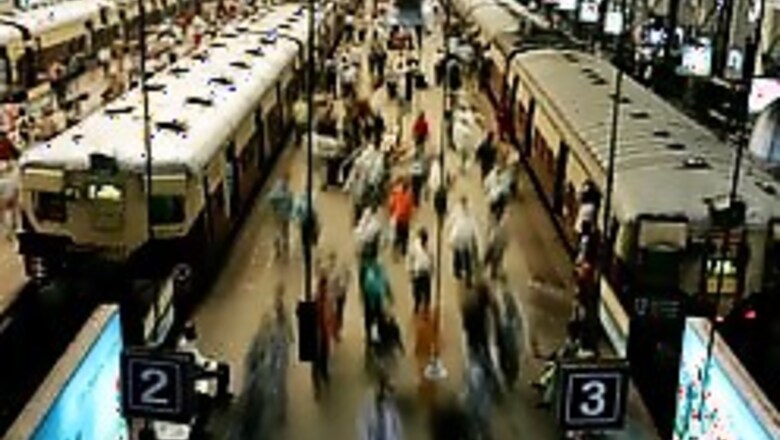
views
New Delhi/Mumbai: The discovery of timers hidden in pencils, the use of remote-control devices and the high-intensity explosives used are indicators to a 'bigger conspiracy' behind the terror blasts in Mumbai, investigators who have rummaged through burnt out coaches say.
Police sleuths have rounded up over 150 people in Mumbai and prepared identikits of suspects based on eyewitness accounts of passengers behaving strangely before the explosions.
They have also recovered timers hidden in pencils in at least three of the seven blast sites.
Mumbai Police have pieced together sketches of four suspects based on eyewitness accounts of the serial train blasts that at latest count have left 198 dead and 714 injured.
The investigators are also probing phone calls made to Karachi and Dubai minutes before and after the blasts. As many as 35 landline calls to locations out of Mumbai are being studied.
In fact, police have come across records that seconds after the blasts at Matunga, Jogeshwari and Borivali, calls were made out to Dubai and Karachi.
Public telephone operators in certain areas have given description of some of the callers.
The blasts in Mumbai on Tuesday were preceded a series of five explosions in Srinagar where nine people were killed.
"Both the strikes in Jammu and Kashmir and Mumbai subsequently have been coordinated. We have some pinpointed information of some modules leading to the bigger plot. But it will be premature to disclose it at this juncture," highly-placed intelligence sources said.
"However, we are confident that this conspiracy will be cracked shortly. An operation of this magnitude leaves behind certain footprints," said an investigator refusing to disclose the vital clues that had been obtained.
The meticulousness of the operation, the explosives used and the use of remote-control devices have raised the possibility of the Lashker-e-Toiba (LeT) being involved, perhaps in collaboration with local groups.
Despite the LeT's stout denial, security agencies believe that only this organisation has the wherewithal to organise such an attack because of its widespread network of fund managers who are able to organise money and explosives.
Just this year alone, police in Delhi were able to thwart several attempts to smuggle in arms and explosives.
"We have intercepts in the past to show where terror has been outsourced. This is a clever strategy to reveal that responsibility does not lie with one single organisation," said one investigator in Mumbai.
According to investigators, the nature of the explosions in the trains suggest that over 50kg of RDX would have been used for assembling the bombs.
Investigators confirmed that most of the bombs were placed in the overhead luggage racks in the first class compartments of the trains.
This seemed to concur with reports from the city's hospitals that victims suffered head and chest injuries, probably caused by blasts above them.
The police are also speculating that the explosive devices had iron nails, nuts and bolts and other iron fillings in them.
A Special Task Force (STF) has been set up to investigate the 7/11 bombings. Inspector General Rakesh Marya, who was in charge of the 1993 Mumbai blasts investigations will help the STF.
Combing operations begun on Wednesday night and the Anti Terrorist Squad is scanning areas identified as SIMI strongholds in Solapur, Nashik, Aurangabad, Beed, Malegaon, Jalgaon and places in Konkan.
SIMI sympathisers all across Maharashtra are being traced and questioned.
Though the needle of suspicion points to the LeT, the several investigating teams formed after the blasts are also looking at the possibility of the involvement of a cadre of the banned Students Islamic Movement of India (SIMI), being trained up outlawed outfits in Bangladesh.
After the March 7 twin explosions in Varanasi, it was discovered that the militants who engineered the attack were reportedly trained by the Bangladesh-based Harkat-ul-Jijad-i-Islami (HUJI).
Similarly, central security agencies established links between the mastermind of the December 28 attack on Bangalore's Indian Institute of Science and the LeT.
Three persons detained - two in Bangalore and one in Hyderabad - were found to have links with the Al-Hadees group based in Bangladesh and Saudi Arabia.
"The LeT has cells in both countries," said an intelligence official.
In fact, five months ago, the Intelligence Bureau (IB) had prepared a position paper of the camps in Bangladesh and Saudi Arabia that were providing support to terror outfits operating in India.
But without the aid of video surveillance footage, which helped the British police identify suspects after the 7/7 attacks in London last year, the job of the Mumbai police force and the intelligence agencies may not be that easy.
Over Wednesday night and Thursday morning, the Anti Terrorism Squad (ATS) conducted a series of raids in several parts of Mumbai and the rest of Maharashtra.
"We have detained some people for questioning and raids are being conducted in many places. However, no one has been formally arrested," Maharashtra Director General of Police P S Pasricha said.
To bolster its investigation, the Maharashtra police has asked former crime branch officers who investigated the 1993 Mumbai blasts that killed at least 270 people to join in.
(With inputs from agencies)


















Comments
0 comment